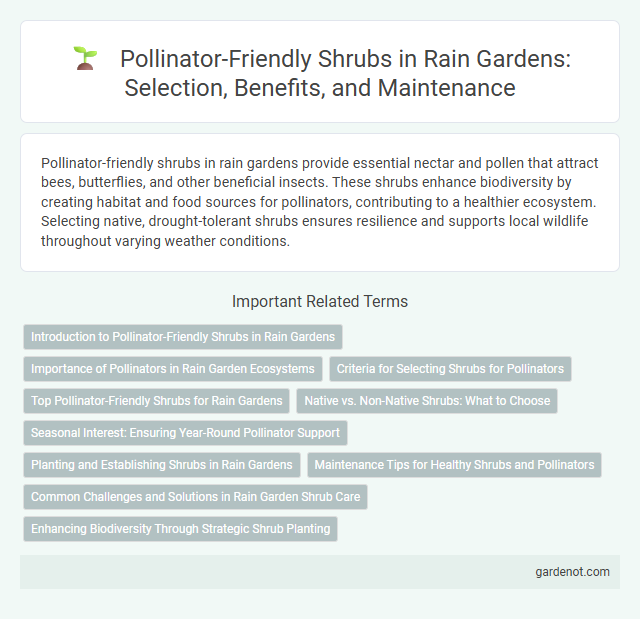Pollinator-friendly shrubs in rain gardens provide essential nectar and pollen that attract bees, butterflies, and other beneficial insects. These shrubs enhance biodiversity by creating habitat and food sources for pollinators, contributing to a healthier ecosystem. Selecting native, drought-tolerant shrubs ensures resilience and supports local wildlife throughout varying weather conditions.
Introduction to Pollinator-Friendly Shrubs in Rain Gardens
Pollinator-friendly shrubs in rain gardens play a crucial role in supporting biodiversity by providing essential nectar and habitat for bees, butterflies, and other beneficial insects. Selecting native shrubs like spicebush (Lindera benzoin) or buttonbush (Cephalanthus occidentalis) enhances local ecosystems while improving rainwater absorption and filtration. These shrubs contribute to the garden's ecological balance, promoting pollination and sustaining healthy wildlife populations.
Importance of Pollinators in Rain Garden Ecosystems
Pollinator-friendly shrubs in rain gardens play a critical role in supporting biodiversity by attracting bees, butterflies, and other pollinators essential for plant reproduction. These shrubs enhance ecosystem resilience by promoting cross-pollination, which increases the genetic diversity and health of native plant species. Incorporating species such as Ceanothus and Summersweet elevates pollinator activity, improving overall rain garden effectiveness in stormwater management and habitat creation.
Criteria for Selecting Shrubs for Pollinators
Pollinator-friendly shrubs for rain gardens should have abundant nectar and pollen, bloom across multiple seasons, and provide habitat or shelter for bees, butterflies, and other pollinators. Native species that are well-adapted to local climate and soil conditions ensure higher survival rates and support native pollinator populations effectively. Selecting shrubs with diverse flower shapes and colors can attract a wider variety of pollinator species, enhancing biodiversity in rain gardens.
Top Pollinator-Friendly Shrubs for Rain Gardens
Top pollinator-friendly shrubs for rain gardens include native varieties like Viburnum dentatum, Clethra alnifolia, and Itea virginica, which provide essential nectar and pollen resources. These shrubs support bees, butterflies, and hummingbirds while thriving in wet conditions, enhancing biodiversity and stormwater management. Selecting diverse species ensures prolonged bloom times, promoting continuous habitat and food supply for pollinators.
Native vs. Non-Native Shrubs: What to Choose
Native pollinator-friendly shrubs in rain gardens offer superior ecological benefits by supporting local butterfly and bee populations, providing essential nectar and habitat. Unlike non-native shrubs, native species are well-adapted to regional soil and climate conditions, requiring less water and maintenance while enhancing biodiversity. Choosing native shrubs such as Ceanothus or Viburnum ensures optimal pollinator attraction and long-term garden sustainability.
Seasonal Interest: Ensuring Year-Round Pollinator Support
Pollinator-friendly shrubs such as Ceanothus, Summersweet, and Spicebush provide essential nectar and pollen throughout multiple seasons, supporting bees, butterflies, and hummingbirds year-round. Their staggered bloom times create continuous foraging opportunities, enhancing biodiversity in rain gardens. Incorporating these shrubs ensures sustained pollinator activity, contributing to a resilient and vibrant ecosystem.
Planting and Establishing Shrubs in Rain Gardens
Pollinator-friendly shrubs in rain gardens thrive when planted in well-drained soil amended with organic matter to retain moisture without waterlogging roots. Establish shrubs during early spring or fall to ensure optimal root development and enhance bloom cycles, supporting consistent pollinator activity. Regular mulching and watering during establishment reduce stress and promote healthy growth, attracting diverse pollinators such as bees, butterflies, and hummingbirds.
Maintenance Tips for Healthy Shrubs and Pollinators
To maintain healthy pollinator-friendly shrubs in a rain garden, ensure consistent watering during dry spells, avoiding over-saturation which can harm root systems. Regular pruning helps promote robust growth and flowering, enhancing habitat quality for bees, butterflies, and other pollinators. Mulching around the base conserves soil moisture, suppresses weeds, and provides a favorable microenvironment for pollinator activity.
Common Challenges and Solutions in Rain Garden Shrub Care
Pollinator-friendly shrubs in rain gardens often face challenges such as poor soil drainage, root rot, and pest infestations due to excessive moisture. Ensuring well-drained soil by incorporating organic matter and installing subsurface drainage can prevent waterlogging and promote healthy root development. Regular monitoring for aphids and spider mites, combined with the use of natural predators or insecticidal soap, helps maintain shrub vitality and supports pollinator populations.
Enhancing Biodiversity Through Strategic Shrub Planting
Pollinator-friendly shrubs like Ceanothus and Itea virginica play a crucial role in enhancing biodiversity within rain gardens by providing essential nectar and habitat for bees, butterflies, and other pollinators. Strategic planting of these shrubs increases floral diversity and extends blooming periods, supporting a wider range of pollinator species throughout the growing season. Incorporating native shrub species adapted to local conditions improves ecosystem resilience and promotes sustainable pollination networks essential for plant reproduction and food webs.
Pollinator-friendly shrub Infographic

 gardenot.com
gardenot.com